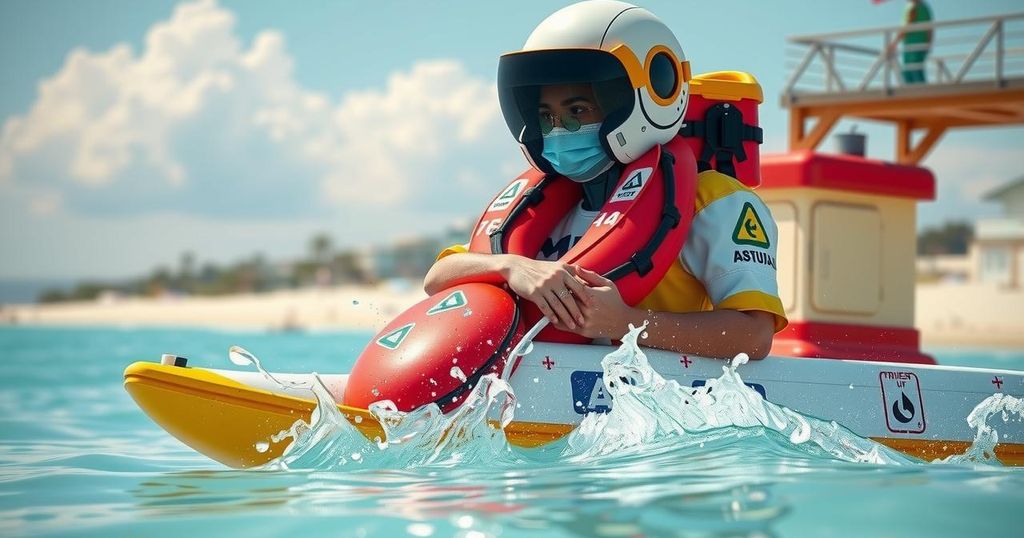AI
ARTIFICIAL INTELLIGENCE, BARRY, COMMUNITY ENGAGEMENT, GOFUNDME, GOULD ADAMS PARK, GOULD ADAMS PARK AQUATIC CENTRE, JAMAICA, JON RAVEN, KINGSTON, LOGAN, LOGAN PUBLIC POOL, MENTAL HEALTH, NORTH AMERICA, PAUL BARRY, QUEENSLAND, RAVEN, RL, RLSQ, ROYAL LIFESAVING SOCIETY QUEENSLAND, RSLQ, SAFETY, UNITED STATES
Rajesh Choudhury
0 Comments
Revolutionizing Aquatic Safety: AI Joins Lifeguards at Logan Public Pool
Logan public pool in Queensland introduces AI technology to enhance drowning prevention by detecting unusual movements and alerting lifeguards. This program, launched at the Gould Adams Park Aquatic Centre, represents a significant innovation in swimming safety, with a focus on supporting human lifeguards, not replacing them. Following recent drowning tragedies, the initiative aims to utilize data for better resource allocation and swimmer safety.
A public pool in Logan will pioneer the integration of artificial intelligence to improve drowning prevention this summer, marking a significant step forward in aquatic safety. Utilizing overhead cameras, the AI technology identifies unusual movements in the water, alerting lifeguards through smart watches that pinpoint distressed swimmers’ locations. Recently launched at the Gould Adams Park Aquatic Centre in Kingston, this innovative approach aims not only to enhance safety but also to gather data on areas in the pool where swimmers may face difficulties.
While AI-assisted tools are already present in pools across the country, this program sets a new precedent for Queensland. Logan Mayor Jon Raven reflected on the tragic drowning of a young girl at a council pool in 2016, saying, “It happened so quickly. The witnesses said they saw the girl playing with her parents and then a moment later she was gone. This technology could have saved her life.”
Royal Lifesaving Society Queensland executive director Paul Barry emphasized that this advanced system is designed to support, not replace, human lifeguards. He noted, “It’s a system that goes 24/7, it doesn’t get tired and doesn’t need a break. Lifeguarding can be boring and distractible.” The implementation of this technology will provide insights into swimming patterns and near-miss incidents, supporting efficient staff deployment without reducing lifeguard numbers.
Moreover, the latest National Drowning report highlights the ongoing dangers of swimming, with 323 deaths reported in the past year—a troubling increase over the previous decade. Notably, six of these incidents occurred in public pools, while the majority took place in backyard settings. This partnership between lifeguards and AI aspires to forge a safer environment for all swimmers at Logan’s pools, with plans for expansion contingent on the technology’s success.
Mayor Raven remarked, “It’ll be about understanding those near misses and seeing how the lifeguards responded to them. If anything, it means we can staff our lifeguards more effectively.” This bold venture into AI-driven safety measures could reshape how public pools operate, changing the tides in the fight against drowning.
The introduction of artificial intelligence at public pools is a groundbreaking evolution in safety technology aimed at preventing drownings, a critical issue as drowning incidents continue to rise. The state of Queensland now observes a shift towards smarter, more proactive measures in lifeguarding, using data-driven insights along with human vigilance. With significant past incidents prompting changes, this innovative technology seeks to bridge the safety gap, underscoring the necessity of evolving our lifesaving tools alongside human oversight.
In summary, the Logan public pool’s pioneering use of artificial intelligence signifies a major step forward in drowning prevention measures, merging human lifeguard efforts with cutting-edge technology. The implementation of AI aims to identify swimming hazards and enhance the lifeguard’s ability to respond effectively. As the program rolls out, it holds the potential to reshape aquatic safety protocols, emphasizing a collaborative approach in safeguarding our swimmers.
Original Source: www.abc.net.au




Post Comment